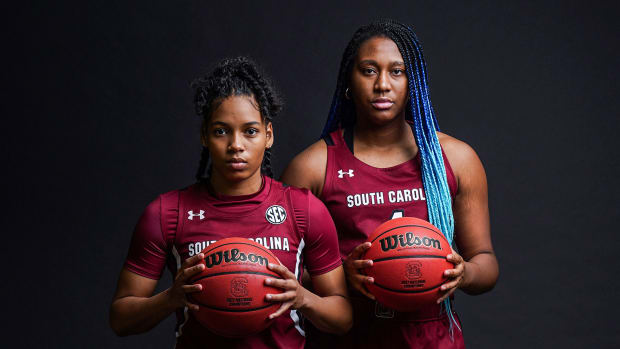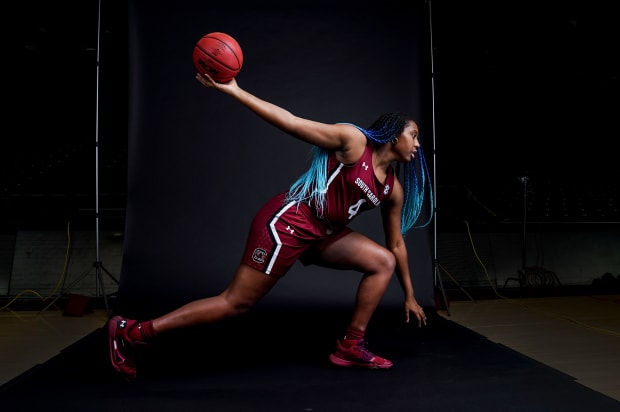From South Carolina at No. 1 to UConn's return to the Big East, previewing what should be a thrilling 2020-21.
After a sudden end to the 2019–20 women’s basketball campaign, the offseason brought change to rosters and—more unexpectedly—on sidelines.
Former Notre Dame coach Muffet McGraw shocked many when she announced her retirement from the Fighting Irish after 33 years as head coach in April. Three months later, Duke coach Joanne McCallie resigned after 13 seasons with the program while Vic Schaefer left Mississippi State to join Texas.
While unanticipated, the suddenly-available positions allowed for impactful hires to be made. Notre Dame was quick to name former player and assistant coach Niele Ivey as McGraw’s successor, while Duke brought on Kara Lawson, a former Celtics assistant and the Blue Devils’ first Black head coach. Additionally, former WNBA player and South Carolina assistant Nikki McCray-Penson will head the Bulldogs’ program.
The new hires headlined an offseason that also saw the exits of three faces of the college basketball: Oregon’s Sabrina Ionescu, Texas A&M’s Chennedy Carter and Baylor’s Lauren Cox. The players all began their WNBA careers after their senior seasons were cut short due to the COVID-19 pandemic.
New leadership and faces make up the women’s basketball field—though familiar teams will likely remain on top entering the 2020-21 season. From South Carolina’s hold at No. 1 to UConn’s return to the Big East, here is a look at power rankings and burning questions for women’s college basketball as the season gets ready to begin on Wednesday, Nov. 25.

Top 10 Ranking
1. South Carolina: The Gamecocks pick up the 2020–21 season where they left off last year: at No. 1. Dawn Staley and the Gamecocks will have to adjust after losing impact players Mikiah Herbert Harrigan and Ty Harris, but the program is set to build off last season’s success with a young group. Reigning national freshman of the year Aliyah Boston, guard Zia Cooke and Brea Beal will lead the way for South Carolina as the team will look to combine young talent with veteran leadership.
2. Stanford: Coming off a 27–6 season and second-place finish in the Pac-12, the Cardinal enter 2020–21 with one of the deepest rosters in the NCAA. Senior guard Kiana Williams leads the way after averaging a team-high 15.0 points and 3.8 assists last season and is joined by top recruits Cameron Brink and Jana Van Gytenbeek. The versatility of Stanford's roster should shine this winter.
3. UConn: The Huskies will be powered by youth with a roster made up of seven new players and zero seniors as they make their return to the Big East. Top-ranked recruit Paige Bueckers leads the incoming group while junior guard Christyn Williams is slated as the team’s leader. UConn will have to make up for the loss of leading scorers Megan Walker and Crystal Dangerfield, but the team can have a high ceiling if its young core can mesh under Geno Auriemma’s leadership
4. Louisville: Despite the departures of starters Jazmine Jones, Kylee Shook and Bionca Dunham, the Cardinals enter this season with new depth. Reigning ACC Player of the Year Dana Evans leads the way for Louisville while standout recruit Hailey Van Lith will be relied on offensively. The Cardinals will be tasked with replacing production but have the pieces to do so.
5. Baylor: The Bears received difficult news when teammates DiDi Richards and Moon Ursin had a scary collision in an October practice, leaving Richards with a spinal cord injury and Ursin with a concussion. While Ursin has been cleared to return to practice, Richards—one of the country’s top defenders—is out indefinitely, though is making progress in her rehab by using a specialized treadmill to run. Baylor may struggle without Richards at the point, but the team has plenty of offensive talent as it will attempt to defend its 2019 national title.
6. Mississippi State: The Bulldogs enter the 2020–21 season under new leadership, as McCray-Penson replaces former coach Vic Schaefer. Mississippi State is built to benefit from an inside attack between sophomore Rickea Jackson, junior Jessika Carter and Michigan State transfer Sidney Cooks. If the Bulldogs can find offensive balance from their guards, the team can move its way up the rankings.
7. NC State: Following a 28–4 season and ACC tournament title, the Wolfpack enter 2020–21 without five of last year’s seniors—but return four starters. While the team will miss the leadership of Aislinn Konig, NC State remains a dominant rebounding team behind junior Elissa Cunane, who averaged 16.4 points and 9.6 rebounds last season. Cunane is joined by Kayla Jones, Jakia Brown-Turner, Jada Boyd and Kai Crutchfield in looking to replace Konig’s production.
8. Arizona: The Wildcats are in line to improve on last season's 24–7 record with the return of dual-impact guard Aari McDonald. A finalist for Naismith Defensive Player of the Year last season, McDonald balanced her staunch protection with a team-high 20.6 points per game. Joining McDonald offensively are Cate Reese and Sam Thomas while transfers Shaina Pellington and Trinity Baptiste will bring versatility for the Wildcats.
9. Oregon: The Ducks will be at a clear loss without four of last year's starters: No. 1 WNBA draft pick Ionescu, No. 2 pick Satou Sabally, No. 8 pick Ruthy Hebard and Minyon Moore. Despite their exits, Oregon brings depth into the new season behind the NCAA's best recruiting class and the addition of transfers Taylor Mikesell (Maryland) and 6' 7" Sedona Prince (Texas). Oregon also returns experience in Erin Boley, Taylor Chavez and Jaz Shelley, but questions lie in how quickly the incoming group will gel during the season.
10. UCLA: The Bruins return four of their starters from last season’s 26–5 squad, anchored by National Player of the Year candidate Michaela Onyenwere. While reaching 1,000 career points last year as a junior, Onyenwere led her team in points (18.9) and rebounds (8.5) per game. Though UCLA loses starter Japreece Dean, the team returns Charisma Osbourne, Natalie Chou and Lauryn Miller, who are expected to step up offensively alongside Onyenwere.

Storylines to Watch/Burning Questions
1. Will South Carolina face challenges in continuing 2019–20’s momentum?
After finishing last season with a 32–1 record, including a 26-game win streak, the Gamecocks enter 2020–21 with their first preseason No. 1 ranking in school history. The team is the clear favorite heading into the year due to its young and talented core of Boston, Cooke and Beal.
South Carolina is built to maintain last season’s dominance, during which it averaged 82.0 points per game, but the team will have to adjust to life without two of its leaders. The Gamecocks lost last season’s leading scorer in Herbert Harrigan, who averaged 13.1 points, and assist leader Harris, who averaged 5.7 assists. Returning veteran players in Lele Grissett, Victaria Saxton and Destanni Henderson will be relied on for leadership and increased production to complement the team’s young talent.
The Gamecocks will be expected to compete for another SEC title and national championship, but the team may face hurdles in chemistry and continuity. Boston and Cooke will star for South Carolina next season, but without Herbert Harrigan and Harris, the team will need to find a new balance between young and veteran players. Coach Staley’s roster has the talent to make that happen.
2. What can be expected from top recruit Paige Bueckers as UConn returns to the Big East?
UConn is no stranger to recruiting top talent, and Bueckers enters the season with high expectations after a standout high school career. During Buecker’s senior season in 2019, the incoming guard averaged 21.4 points, 9.4 assists and 5.0 rebounds while standing out defensively with 5.4 steals per game.
Auriemma has made it clear that Bueckers, though talented, is not going to single-handedly lead the Huskies to a championship. The Gatorade Female High School Athlete of the Year is expected to run point for UConn as the team will be without Dangerfield, who averaged a team-high 3.9 assists per game. Additionally, Buckers has discussed that she has tried to take on a leadership role among the incoming class of seven players, including six freshmen.
UConn, coming off a down season compared to the program’s standard, is entering 2020–21 looking for its first championship since 2016. Bueckers brings high talent to the Huskies, but she has said the team’s overall success is what matters most to her this season. UConn will be tasked with finding chemistry among its young roster, and Bueckers will not be alone as juniors Williams and Olivia Nelson-Ododa look to lead the way.
3. How will Oregon adjust without Sabrina Ionescu and last year’s starting core?
The Ducks were a must-watch last season due to their high-scoring core of Ionescu, Sabally, Hebard and Moore. Oregon led the NCAA in points per game powered by transcendent talent Ionescu, who averaged 17.5 points, 9.1 assists and 8.6 rebounds and recorded 26 triple doubles in her career (14 more than any other player in NCAA history, men’s or women’s).
That type of dominance and consistency is difficult to replicate, but Oregon is well suited to adjust this season with five top-25 recruits joining the roster. Coming off a 31–2 record and No. 2 ranking at the end of last season, the Ducks will have depth on their side as they transition to new floor leaders. Beyond the talented incoming class, Oregon will rely on returning veterans Boley, Chavez and Shelley while adding transfers Mikesell and Prince.
The potential for Oregon exists, but it will come down to how quickly new and existing talent can find chemistry. The team will quickly be tested by Stanford in the Pac-12, who are ranked No. 2 entering the season. Ionescu, Sabally and Hebard have skillsets that are difficult to replace, but Oregon’s incoming talent and veteran core gives it a chance to compete for its fourth consecutive Pac-12 regular-season title.
4. Which team is a sleeper to make the Final Four?
While Baylor can be a candidate to make the Final Four pending the return of reigning Defensive Player of the Year Richards, Arizona is well-built to make a jump into national championship contention. Led by a candidate for National Player of the Year in McDonald, the Wildcats have what could be a productive balance of returning players and new additions that can have an immediate impact.
Arizona finished No. 12 in the nation and fourth in the Pac-12 last season with a 24–7 record, trailing Oregon, Stanford and UCLA. Stanford has the edge entering 2020–21, but Arizona has a chance to move ahead by increasing its offensive production. The team’s strength last season was its defense, which allowed just 56.6 points per game—24th-best in the country—compared to scoring an average of 69.1 points—good for 93rd-best.
McDonald benefits Arizona on both sides of the ball and will be surrounded by returning top scorers in Reese and Thomas, along with transfers Pellington and Baptiste. If the Wildcats’ offense can step up alongside their strong defense, it would not be surprising to see Arizona make a run to the Final Four.